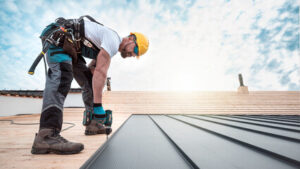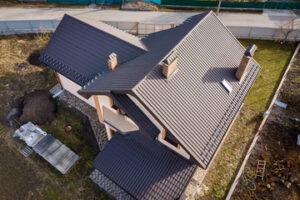A sturdy roof protects people and possessions inside your home, boosts curb appeal, and can help you recoup some of your investment when you sell. However, there may come a time when your home’s roofing needs replacing.

A new roof is a significant investment, so it’s a decision that should not be taken lightly. A professional at Roof Replacement NJ will inspect your current roofing, note its condition, and discuss your preferences.
The size of your home and the type of roofing material are the main factors in determining the cost to replace your roof. However, there are other influencing factors that can add or subtract from the overall cost.
For example, the steepness of your roof’s pitch can affect the amount of materials and labor that will be needed to complete the project. Generally, the steeper your roof is, the more expensive it will be to replace. Similarly, features such as skylights, dormer windows and chimneys will increase your roof replacement costs as they may require special flashing or other unique roofing materials.
Another factor that can influence your roof replacement costs is the amount of cleanup and disposal that will be required after the old materials are removed from your roof. This is something that you should discuss with your New York roofers to ensure it’s included in the initial quote. Finally, some states require that a building permit be obtained before starting work on your roof. These permits typically include a fee that will be tacked onto your total roof replacement costs.
The cost to repair your roof depends on the extent of damage and whether a full replacement is necessary. Minor repairs like a few missing or damaged shingles can be addressed for as little as $150. But, if the damage is widespread or signs of rot or mold are present, it’s more practical to invest in a full roof replacement.
On average, up to 60% of your roof replacement costs will be attributed to labor. This includes the labor and materials needed to tear off the existing roof, install the new roofing material, and then clean up and dispose of the old materials.
The remaining 40% to 50% of your roof replacement costs will be attributed toward the materials that are used. This can include a variety of things from the actual roofing material (shingles, shakes or tiles) to other items such as underlayment, vents, ridge caps and roof shingles. Lastly, any local taxes or fees will be added to your final bill.
Materials
There are many roofing materials from which to choose, and each one offers different advantages and disadvantages. The type of material you choose will also affect the cost and lifespan of your new roof, so it’s important to carefully consider the options.
For example, wood shingles or shakes offer a traditional aesthetic and are less expensive than metal but are susceptible to rot, moss, and insect damage. A metal roof, on the other hand, is durable and highly wind-resistant and can last up to 70 years. It is also very energy efficient, which will lower your utility bills.
If you’re unsure which material to choose, ask your roofing contractor for recommendations. They will be able to explain the pros and cons of each option and help you find a solution that meets your needs. They will also be able to tell you whether or not the materials you choose meet your local building codes and fire safety standards.
When calculating your roof replacement costs, keep in mind that any taxes or fees that may apply will be added to the total. These could include landfill fees for discarded materials, sales tax on materials, and any other applicable local charges. To avoid these additional costs, it is best to schedule your roof replacement during the off-season, which is usually fall and early spring.
Another factor that can affect the overall cost of your roof replacement is the condition of the existing roof decking. In many cases, the old shingles will need to be removed in order to install the new ones, which can add to the total project cost. This can be avoided by using OSB or CDX plywood sheets in 4 by 8 feet sizes, which are generally available at home improvement stores. These are a great substitute for the soft or rotten wood decking that oftentimes exists in older homes.
Installation
If your roof is beginning to show signs of aging, it’s important to act quickly. The longer you wait, the more likely it is that moisture will seep into your home and damage interior structures. It’s also possible that moss and mold will begin to grow on the dark areas of your roof, which can cause boards underneath to rot and your entire roof to collapse. If you aren’t ready to invest in a new roof, you can still protect your home by having the existing shingles removed and laying down a layer of water-resistant underlayment.
The length of time that the roof replacement process will take depends on a few different factors, such as the size of your roof and the type of roofing materials you select. Asphalt roofs are typically completed within a day, while metal roofs can take up to a week. It’s best to discuss these details with your roofer before you choose a date for the work to begin.
You will need to be sure that you have the necessary permits and inspections in place for your roofing project. Building permit requirements vary from location to location, but generally, you will need to submit plans for the roof and receive a sign-off from a building inspector before construction begins.
Once the permits are in place, the roofing team will remove your old shingles and underlayment. You should make sure to cover anything that can be damaged by hammers, such as plants and movable furniture. Large tarps can also be helpful to catch stray nails and debris. In addition, it’s a good idea to keep your pets indoors for the duration of the roof replacement, as hammers and strangers can be disturbing to them.
Once the roofing team has disposed of your old roof, they will start installing the new one. You should consider adding vents during this phase to help with attic ventilation and improve energy efficiency. You can also use this opportunity to add gutter guards to prevent blockages and clogging from debris from the roof tear-off.
Warranty
Often, roofing materials come with a warranty that will cover certain issues for an extended period of time. However, if the proper maintenance isn’t performed or there are other unforeseen circumstances, those warranties can end up being null and void. The best way to avoid this from happening is by reading all of the fine print that comes with the manufacturer’s warranty and working with a roofing contractor who offers their own workmanship and system warranties in addition to those offered by the manufacturers.
Manufacturer warranties are offered by the product manufacturers and can vary in length from a few years to several decades depending on the product. They usually cover manufacturing defects. However, they do not typically cover the installation or replacement of the roof, which is covered by a workmanship warranty.
Workmanship warranties are offered by roofing contractors and can range from one to ten years. These warranties cover the installation of the roof and can include things like ridge caps, underlayment, flashing, and leak barriers. Manufacturers may offer additional warranty plans that provide greater coverage for the entire roofing system and last up to 30 years.
It is important to remember that roofing warranties only provide protection for the specific products installed on your home. Mixing and matching roofing materials to save money is a sure way to void your warranties. If you want to have peace of mind and the most protection possible for your new investment, stick with the same roofing material throughout your home, even if it’s more expensive.
It is also important to know that the roof repair and maintenance that are not covered by the roof’s warranty will most likely be covered under your homeowner’s insurance policy. Other things that are excluded from roofing warranties such as severe storm damage or building settlement can be covered by a separate policy or additional insurance coverage that you may want to consider. To ensure that you have a valid warranty and that you get any benefits that it may offer, be sure to register your warranty with the manufacturer and present your roofing contractor with proof of purchase when the job is completed.
